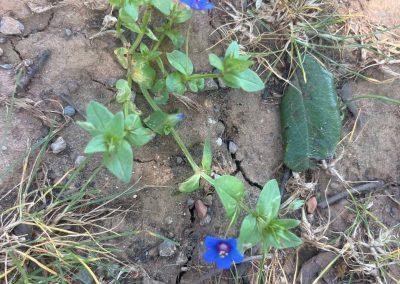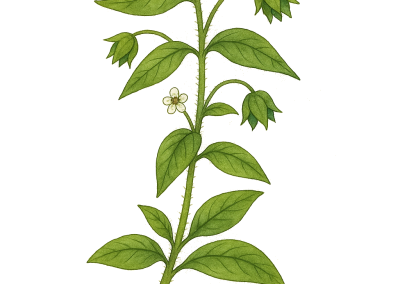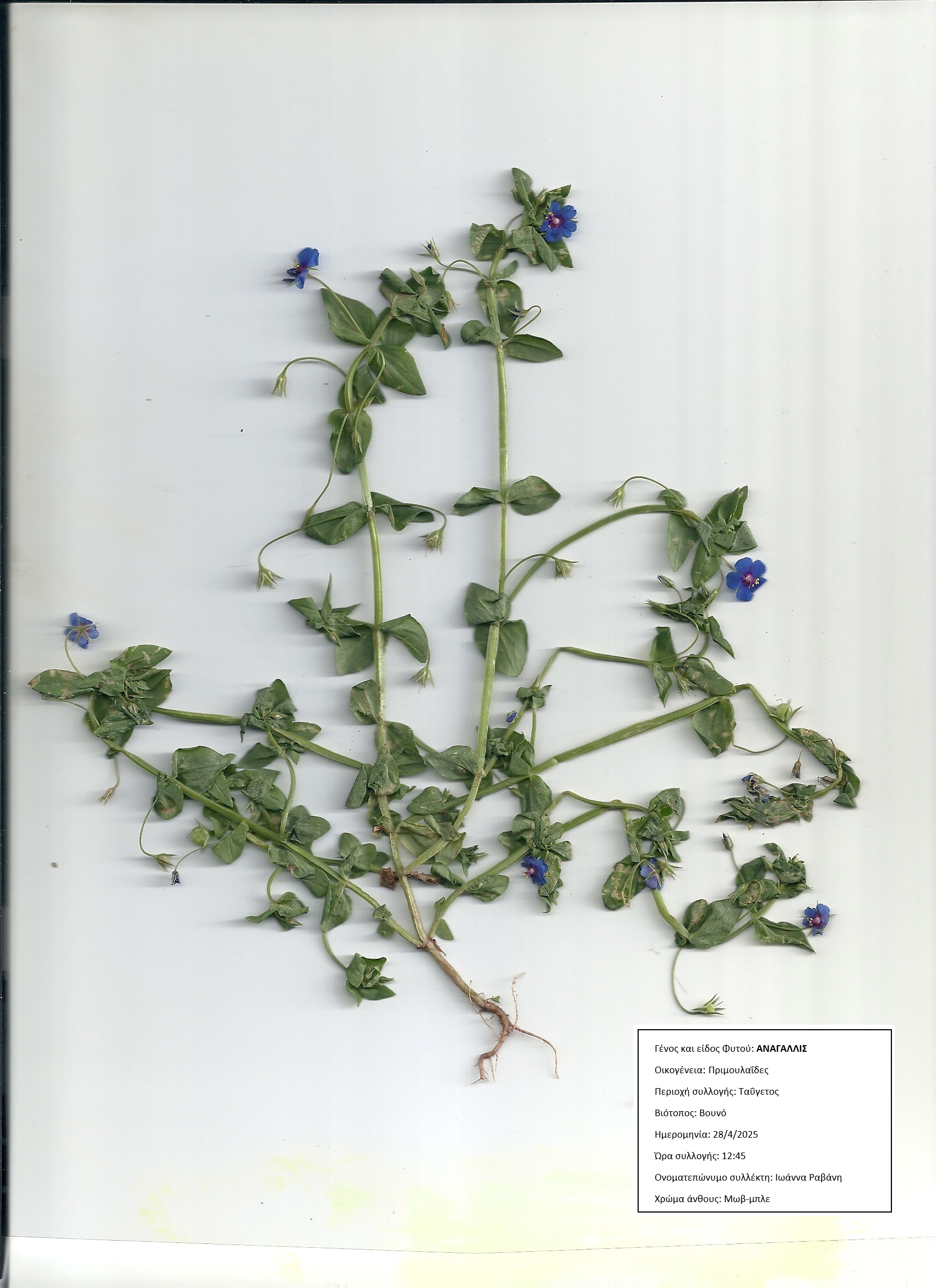Anagallis arvensis
Scientific description
Scientific name: Anagallis arvensis
Common name: Scarlet Pimpernel, Red Pimpernel, Poor Man's Weatherglass
Kingdom: Plantae
Family: Primulaceae
Genus: Anagallis
Species: Anagallis arvensis
Etymology:
Derived from Greek 'ana' meaning "again" and 'agallein' meaning "to delight in," referring to the plant flowering twice a year and opening its flowers whenever the sun strikes them.
Origin:
Native to Europe, Western Asia, and North Africa. Widely naturalized in temperate and subtropical regions worldwide.
Ecology:
Found in disturbed habitats like agricultural fields, gardens, roadsides, and waste areas. Prefers sunny, well-drained locations but adaptable to different soil types. Thrives in temperate climates and can act as a low-growing invasive weed.
Description:
Low-growing, spreading annual or sometimes perennial herb, 5–30 cm tall. Leaves small, ovate, opposite or in whorls. Flowers small (~1 cm), usually bright red or orange-red, occasionally blue. Flowers grow singly from leaf axils, opening in direct sunlight and closing in overcast or rainy weather. Produces small capsules with many seeds.
Propagation:
Mainly by seeds; each plant produces many seeds aiding wide distribution.
Usage:
• Traditional medicine: treats mental disorders, wounds, diuretic.
• Caution: contains toxic compounds; can be poisonous to livestock and humans if consumed in large quantities.
Επιστημονική ονομασία: Anagallis arvensis
Κοινά ονόματα: Κοκκινολάμπη, Κόκκινη Ανάγαλλη, Βαρόμετρο του Φτωχού
Βασίλειο: Φυτά (Plantae)
Οικογένεια: Πριμουλαΐδες (Primulaceae)
Γένος: Anagallis
Είδος: Anagallis arvensis
Ετυμολογία:
Από τα ελληνικά «ἀνά» (ξανά) και «ἀγάλλεσθαι» (ευφραίνομαι), πιθανώς λόγω του ότι ανθίζει δύο φορές το χρόνο και τα άνθη ανοίγουν στον ήλιο.
Καταγωγή:
Ενδημικό στην Ευρώπη, Δυτική Ασία και Βόρεια Αφρική. Έχει εξαπλωθεί και εγκλιματιστεί παγκοσμίως.
Οικολογία:
Σε διαταραγμένα οικοσυστήματα όπως αγροί, κήποι, άκρες δρόμων και περιοχές με απορρίμματα. Προτιμά ήλιο και καλά στραγγιζόμενα εδάφη. Ευδοκιμεί σε εύκρατα κλίματα και μπορεί να είναι χαμηλό, επεκτατικό ζιζάνιο.
Περιγραφή:
Μονοετές ή σπάνια πολυετές βότανο, 5–30 cm. Φύλλα μικρά, ωοειδή, αντίθετα ή σε σπονδύλους. Άνθη μικρά (~1 cm), συνήθως κόκκινα ή πορτοκαλοκόκκινα, μερικές φορές μπλε. Άνθη μονά ή ζευγαρωτά στις μασχάλες φύλλων, ανοίγουν στον ήλιο, κλείνουν σε συννεφιά ή βροχή. Παράγει μικρές κάψουλες με πολλούς σπόρους.
Πολλαπλασιασμός:
Κυρίως με σπόρους. Κάθε φυτό παράγει πολλούς σπόρους, διευκολύνοντας τη διάδοση.
Χρήσεις:
- Παραδοσιακή φυτοθεραπεία: ψυχικές διαταραχές, πληγές, διουρητικό.
- Προσοχή: τοξικό, μπορεί να βλάψει ζώα και ανθρώπους αν καταναλωθεί σε μεγάλες ποσότητες.
Nom scientifique : Anagallis arvensis
Nom commun : Chaperon écarlate, Chaperon rouge, Sablier du pauvre
Règne : Plantae
Famille : Primulaceae
Genre : Anagallis
Espèce : Anagallis arvensis
Étymologie :
Du grec 'ana' ("à nouveau") et 'agallein' ("se réjouir de"), pour la floraison deux fois par an et ouverture des fleurs au soleil.
Origine :
Europe, Asie occidentale, Afrique du Nord. Naturalisation mondiale en zones tempérées et subtropicales.
Écologie :
Habitats perturbés : champs, jardins, bords de route, déchets. Préfère soleil et sols bien drainés, adaptable. Peut être envahissante basse dans certaines régions.
Description :
Herbe annuelle ou parfois pérenne, basse, 5–30 cm. Feuilles ovales, opposées ou en verticilles. Fleurs ~1 cm, rouges ou orange-rouges, parfois bleues. Fleurissent individuellement à l'aisselle des feuilles, ouvertes au soleil, fermées par temps couvert. Capsules avec nombreuses graines.
Propagation :
Principalement par graines, nombreuses graines par plante favorisant la diffusion.
Utilisations :
• Médecine traditionnelle : troubles mentaux, blessures, diurétique.
• Attention : composés toxiques, dangereux pour animaux et humains en grande quantité.
Denumire științifică: Anagallis arvensis
Denumiri populare: Pimpinela stacojie, Pimpinela roșie, Barometrul săracului
Regn: Plantae
Familie: Primulaceae
Gen: Anagallis
Specie: Anagallis arvensis
Etimologie:
Din grecescul 'ana' ("din nou") și 'agallein' ("a se bucura"), datorită înfloririi de două ori pe an și deschiderii florilor la soare.
Origine:
Europa, Asia de Vest, Africa de Nord. S-a naturalizat global în regiunile temperate și subtropicale.
Ecologie:
Habitate deranjate: câmpuri, grădini, margini de drum, locuri abandonate. Preferă soare și sol bine drenat, adaptabil. Poate fi invazivă joasă în anumite regiuni.
Descriere:
Plantă erbacee anuală sau uneori perenă, joasă, 5–30 cm. Frunze ovale, opuse sau în verticile. Florile ~1 cm, roșii sau roșu-portocalii, uneori albastre. Crește solitar în axila frunzelor, se deschide la soare, se închide în condiții de cer acoperit sau ploaie. Capsule mici cu numeroase semințe.
Înmulțire:
Prin semințe, numeroase per plantă, favorizând răspândirea.
Utilizări:
● Medicina tradițională: tulburări mentale, răni, diuretic.
● Atenție: conține compuși toxici, periculoasă pentru animale și oameni dacă se consumă în cantități mari.
Creative writing inspired by Anagallis arvensis
Anagallis arvensis — The Legend of the Scarlet Star
Long ago, in a small village by the Mediterranean Sea, there lived a humble healer named Eleni. She was known far and wide for her remedies, her kindness, and her secret knowledge of the plants whispered about by the wind and waves.
One year, the village faced an unusual misfortune. The skies darkened for weeks, the rains flooded the fields, and the sun seemed lost behind endless clouds. The crops withered, and the villagers grew ill and weary. Desperate, they pleaded with Eleni to find a cure not only for their bodies but for their broken spirits.
Eleni climbed the rocky hills where few dared to tread, seeking guidance. There, amid the misty stones, she encountered a strange sight — a carpet of tiny, brilliant flowers, their petals a fiery red. Each bloom shivered under the dim light, but as Eleni knelt to touch one, a miracle occurred: a single ray of sunlight broke through the clouds and bathed the flowers in gold.
A voice, light as the sea breeze, filled the air: "This is the Flower of the Lost Sun. When light meets sorrow, these petals will open to remind the world of hope."
Understanding the gift, Eleni gathered the flowers carefully. She brewed them into teas and crafted small sachets for the villagers. Whenever a sachet was placed near a bed, the sick dreamed of warm, bright summers, and slowly, strength returned to their limbs. When they wore garlands woven from the Scarlet Pimpernel, laughter echoed once again through the village streets.
Most magical of all, the flowers themselves seemed to dance — opening wide whenever the sun appeared, and closing protectively when storms approached, as if they could sense the world's moods.
From then on, the villagers called Anagallis arvensis not just the "Scarlet Pimpernel," but also the Star of Hope. They believed it carried a piece of the sun's own heart — a reminder that even after the darkest storms, the light would always return. And to this day, in forgotten gardens and by quiet roadsides, the Scarlet Pimpernel continues its ancient duty: to bloom bravely under the sun, and to close gently when the world weeps.







